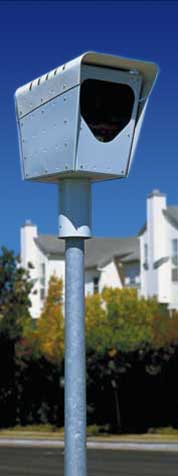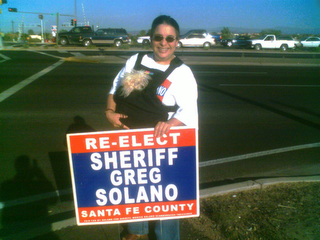
Last Tuesday the City Police Department asked for and received the go-ahead from the Public Safety Committee to research the installation of cameras to catch drivers in the act of running red lights. You may remember a post I had discussing the Red Light Camera's in Albuquerque in April of this year.
The City Police Department will be looking at starting a pilot program to catch red light runners on cameras similar to those used by an Albuquerque program that has been in operation since May 2005. The city is looking at placing the camera's at five Santa Fe intersections in the pilot project: St. Francis Drive and Zia Road and Cerrillos Road's intersections with Airport Road, Zafarano Drive, St. Francis Drive and St. Michael's Drive.
The use of these cameras to issue official criminal traffic citations is illegal in the state of New Mexico. State Law requires citations to be given by a uniformed certified officer who must witness the infraction. The only exception is in the case of an accident when the officer can rely on evidence at the scene and witness statements to issue the citations. So how does Albuquerque use the Red Light cameras to issue citations? They do this through a civil action.
The citations issued are civil summons issued by the city through a private company. The only cause of action if you do not pay the citation is for the city to take civil action and boot your vehicle under civil forfeiture ordinances until you pay. If you do pay the citation then the only penalty is the cash you send to the city. No matter how many citations you get for running red lights by the cameras you will not receive points on your M.V.D. records. Your insurance companies will not know you even received a citation. The penalty is cash and or impoundment. Violators are fined $100 the first time, $250 plus a 30-day impound of the vehicle for the second time. For subsequent offenses, there is a $500 fine plus a 90-day impound. The city saves on storage fees by impounding your car in your own driveway by booting the vehicle.
A city police officer reviews each citation before it is issued. The Citations are issued by a private company "Redflex" who supplies the camera's, prints and mails the citations, collects the payments and in turn keeps a portion of the fees collected. Redflex is a rapidly growing company whose year end revenue for the year which ended June 30, 2005 increased 39.7% to $46.3 million, while net profit after tax increased 171% to $9 million. Most of the revenue and profit came from traffic camera installations in Australia and the US,
Albuquerque has generated $1.2 million in revenue for the city since the city began using camera's in October of 2005. During the Santa Fe City Public Safety Committee meeting last Tuesday, members of the committee cautioned city staff not to bill the cameras as a revenue generator, but rather as a way to alter driving habits and ultimately save lives. This came after Deputy Chief Ray Byford said any estimate of how much Santa Fe could earn from a similar system would be a "shot in the dark," but added that "it could be way up there."
The ACLU has begun challenging Speed and Red Light Camera's in different parts of the nation. They have begun pointing to Studies (one in Washington in particular) which seem to show increases in accidents in some areas where Red Light Camera's are used. Santa Fe is a much more liberal and outspoken community than Albuquerque, it will be interesting to see the publics reaction to any camera's installed in Santa Fe especially if the fines are as hefty as those set in Albuquerque.
The Washington Times reported in June of 2005 Red-light cameras in Northern Virginia were shut down after a 10-year pilot program expired. A state legislative committee voted not to continue the automated traffic-enforcement program, which had been operating in six Northern Virginia localities and Virginia Beach. Critics, including delegates who voted to end the program, said the cameras are money-making devices that invade a residents’ privacy and cause rear-end collisions. Interestingly enough the program in Virginia charged $50 as compared to the hundreds in fines charged by Albuquerque. Virginia reported a loss in revenue for the program costing the government entities up to one million dollars in 5 years. Apparently the rear end collisions occur when drivers stop for the red lights even though they are being tailgated for fear of receiving the citation. It has been argued that otherwise the driver may have run the light to avoid the rear end collision.
Some County Commissioners have brought up red light camera's as a tool to be used in the county over the last few years. This is something which I feel has both positive and negative connotations. I have really looked at disdain when the media researches citations issued by Red Light Camera's in Albuquerque and look for politicians, government workers, police officers and other notables who are caught running the lights. They then show the photos or videos of these people in news reports. I would like to see them show reporters and media staff who are caught as well. I know that public officials have much less expectation of privacy but this is a low way to just have a another titillating story.
I also really see a problem when traffic citations are used as a revenue source. Unlike the view of many cited motorists, there are no quotas. We do not raise the Sheriff's Office Revenue by issuing citations. Quota's promote abuse and bad citations issued by deputies who just need to pull over citizens in order to reach their quota. We do receive $1 (one dollar) for every citation that is plead or found guilty in court. Most are not, usually people go to driving school or get a deferred sentence and we do not get the dollar. Last year I believe we got about $10,000 from the thousands of citations we issued. This was out of a taxpayer provided 2006/2007 budget of just under nine million dollars. The bottom line is we give citations as educational tools, not to raise money.











